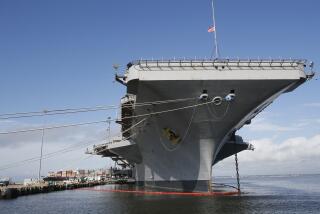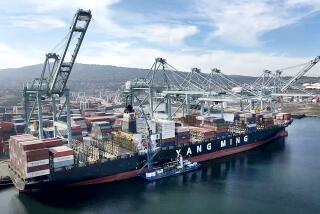Union Workers Discuss Idea to Acquire Nassco
- Share via
Union workers at the National Steel & Shipbuilding Co. are meeting with a consultant to discuss the possibility of buying the financially strapped shipyard and making it employee-owned.
Barbara Norton, a Quincy, Mass., consultant who is involved in another employee buyout of a shipyard, said “the time is right” for Nassco workers to study that possibility. Under optimum conditions, Norton said, workers could inform the company within 12 months of their intention to buy the shipyard and complete the purchase within three years.
“Nassco has severe financial problems, otherwise they wouldn’t have reduced workers’ wages,” Norton said. “I think that the parent company can only carry the shipyard so long before they’ll have to let it go. They think they can hold on to it for four to five years and possibly sell it, but I don’t think so.”
Shake-Up Disclosed
Morrison-Knudsen Corp., the parent company, announced a corporate shake-up Tuesday and said Nassco officials will now report directly to William Agee, president, chairman and chief executive officer of Morrison-Knudsen. Nassco reported a $20-million loss for the second quarter of 1988--and the shipyard only has a $60-million Navy repair contract, which is scheduled to end in November, and a $290-million construction contract for a speedy Navy combat support ship. That pact ends in three years.
In its peak year, 1980, the company employed 7,600 workers and was the largest privately owned shipyard on the West Coast. In the 1970s, Nassco was a major builder of commercial ships, constructing 38 before companies began buying their vessels from Korean and Japanese shipyards. Today, the company employs about 1,800 workers and relies almost exclusively on Navy contracts.
Norton, 45, has assisted workers in their effort to buy the Quincy Fore-River shipyard in Quincy, Mass. General Dynamics closed the yard and sold the property to the state in November, 1987. Workers and state officials are completing an agreement on the purchase of part of the shipyard, she said. Avondale in New Orleans and Unimar in Seattle are the only employee-owned shipyards in the United States.
Norton said about 87 shipyards are left in the country, after 40 closed in the past eight years.
For workers to purchase Nassco, they will have to agree on a legal strategy, line up financing and, most importantly, familiarize themselves with the ownership options available, Norton said. With Navy contracts shrinking, and commercial contracts nonexistent, Nassco would have to diversify under employee ownership.
Besides building ships, the Avondale yard builds railroad cars and computer components. The company is also a scrap-metal broker, she said.
But Is Yard for Sale?
Employees may be talking about buying Nassco, but company officials have not indicated that the shipyard is for sale.
“The company understands that employees are investigating it,” said Fred Hallett, Nassco spokesman and vice president. “The company understands that this is strictly an independent employee evaluation, and it is not something that the company is undertaking.”
Hallett said he is not familiar with Norton’s credentials, but he pointed out that there are significant differences between the Quincy Fore-River and Nassco yards.
“The General Dynamics shipyard was closed by the parent company,” Hallett said. “All employees were laid off. Nassco is a continuing yard with a backlog and labor contract and is aggressively pursuing additional work. So, the two cases are not parallel.”
As explained by Norton, if workers succeeded in buying Nassco, they would own at least 51% of the company. Every worker, from the lowest paid to the top manager, would own an equal amount of stock.
“The stock would be worth the same value, and everybody would own an equal amount,” Norton said. “This is to prevent someone from taking internal control. . . . The stock would be worth the same across the board.”
As explained by Norton, higher-paid workers would be able to pay for their stock purchases faster, through automatic payroll deductions. Typically, if a worker earned $10.96 an hour, the 96 cents would be deducted every hour to pay off the stock purchase. If the worker received a wage increase to, say, $11.50 an hour, the 50 cents would be deducted on top of the previous 96 cents, for a total of $1.46 an hour, to pay off the stock purchase.
In an employee-ownership program, unions and Nassco’s present management team would not be excluded, Norton said. But managers would have to agree to a salary reduction in return for being owners.
Should the company fail, workers would probably lose their equity investments and any profits accumulated in their accounts, but they would not be held personally responsible for the company’s debts, Norton said.
Though Norton is optimistic about the workers’ chances to buy Nassco, Jack Curtis, a lawyer and expert in employee buyouts, said it would probably be a difficult if not impossible task as long as the shipyard continues to lose money.
“It is very difficult to take a company that is losing money and have employees buy it,” Curtis said. “Frequently, they run into insurmountable problems getting financing. A deal like this can be done only if the parent company will self-finance. . . . But it’s another thing to go out and get lenders to loan money for the purchase of a company that’s not doing well financially.”
In a situation like Nassco’s, workers would also probably have to agree to further wage concessions to obtain financing to buy the shipyard, Curtis said.
Unilateral Pay Cuts
Nassco officials unilaterally cut workers’ wages, ranging from 17% to more than 50%, a few days after the old contract expired Sept. 30, 1987. Journeymen’s wages were reduced to $10.80 an hour, from $12.80. Unskilled workers suffered a bigger cut, going to $5.55 from $12.05.
Union workers signed a new contract with the company last month, after a three-week strike. The new agreement did not bring wages to the level they were in September, 1987.
More to Read
Inside the business of entertainment
The Wide Shot brings you news, analysis and insights on everything from streaming wars to production — and what it all means for the future.
You may occasionally receive promotional content from the Los Angeles Times.










